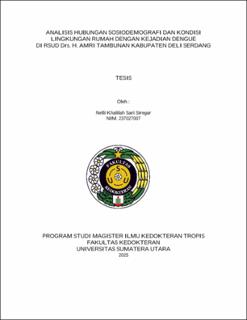Analisis Hubungan Sosiodemografi dan Kondisi Lingkungan Rumah dengan Kejadian Dengue di RSUD Drs. H. Amri Tambunan Kabupaten Deli Serdang
Analysis of the Relationship Between Sociodemographic Factors and Home Environmental Conditions with the Incidence of Dengue at RSUD Drs. H. Amri Tambunan, Deli Serdang Regency

Date
2025Author
Siregar, Nelli Khalilah Sari
Advisor(s)
Lubis, Inke Nadia Diniyanti
Yanni, Gema Nazri
Metadata
Show full item recordAbstract
Background. Dengue infection is a significant public health issue in Indonesia.
Although traditionally associated with urban environments, dengue is now
increasingly reported in semi-urban and rural areas. This is driven by widespread
human mobility, infrastructure development, and global climate change. This
highlights the need to understand the risk factors that contribute to the spread of
dengue in semi-urban areas. This study aims to investigate the relationship between
sociodemographic risk factors, household environmental conditions, and dengue
incidence in North Sumatra, Indonesia. Methods. This study was conducted in the Deli
Serdang District, North Sumatra Province, Indonesia. Participants were identified
through medical records from Drs. H. Amri Tambunan General Hospital. Cases and
controls were treated between July and September 2024, with medical records
reviewed and questionnaires on sociodemographic factors and household
environmental conditions completed via a Google Form shared through WhatsApp
application. Out of 238 screened participants, 39 cases and 78 controls were identified.
Result. We identified [adjusted OR (aOR) = 6.7, 95% CI 1.3–33.7, P = 0.021], student
status (aOR = 7.8, 95% CI 1.1–56.5, P = 0.042), absence of wire mesh on ventilation
(aOR = 12.9, 95% CI 3.1–53.8, P < 0.001) and the presence of bushes around the
house (aOR = 7.3, 95% CI 1.7–31.9, P = 0.008) were significant risk factors for dengue
incidence. Conclusion. Gender, student status, absence of window screens, and the
presence of bushes are associated with dengue incidence. The absence of window
screens is the dominant influencing factor. Interventions such as urban planning,
improving home environmental conditions, and increasing public awareness and
behavioral changes are crucial for reducing the risk of dengue.
